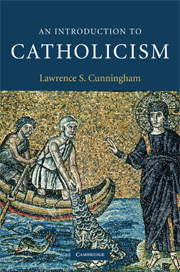Book contents
- Frontmatter
- Contents
- Illustrations
- Preface
- Acknowledgments
- 1 The many meanings of Catholicism
- 2 Roman Catholicism
- 3 Being Catholic: Some typologies
- 4 Catholicism in place and time
- 5 Catholic worship
- 6 The rule of faith
- 7 Catholic spirituality
- 8 The missionary character of Catholicism
- 9 Catholic reformation(s)
- 10 The moral life
- 11 The contemporary Catholic Church
- 12 Reading Catholicism: Bibliographical resources
- Index
- References
6 - The rule of faith
Published online by Cambridge University Press: 05 June 2012
- Frontmatter
- Contents
- Illustrations
- Preface
- Acknowledgments
- 1 The many meanings of Catholicism
- 2 Roman Catholicism
- 3 Being Catholic: Some typologies
- 4 Catholicism in place and time
- 5 Catholic worship
- 6 The rule of faith
- 7 Catholic spirituality
- 8 The missionary character of Catholicism
- 9 Catholic reformation(s)
- 10 The moral life
- 11 The contemporary Catholic Church
- 12 Reading Catholicism: Bibliographical resources
- Index
- References
Summary
INTRODUCTION
Every religious body has some kind of standard of belief that is frequently reducible to a core statement that attempts to capture the essence of what that body stands for. For Buddhism, it consists of the “Four Noble Truths” about suffering and its remedy, while for Jews it is the daily repeated prayer or act of faith, drawn from the Torah, known as the Shema: “Hear, O Israel, the Lord is our God, the Lord alone. You shall love the Lord your God with all your heart, and with all your soul, and with all your might” (Deut. 6:4). In Islam, the basic creed is simplicity itself: “There is but one God (Allah), and Mohammad is his prophet.” Behind those simple formulas, of course, is a fuller body of doctrine that answers questions of inquiring minds: What does this or that phrase mean? Why should it be believed? How does it apply to our daily lives, etc? In other words, simple statements of belief cannot be seen in the abstract. They are uttered by real people in real circumstances and have behind them a complex of rites, convictions, ideas, and moral imperatives.
The earliest writings of the Christian community, the various letters that Saint Paul wrote to Church communities, already reflect disputes about what it meant to be a follower of Jesus. Did these followers have to follow the prescriptions of the Jewish law? Did they have to be circumcised if they were male?
- Type
- Chapter
- Information
- An Introduction to Catholicism , pp. 124 - 146Publisher: Cambridge University PressPrint publication year: 2009



